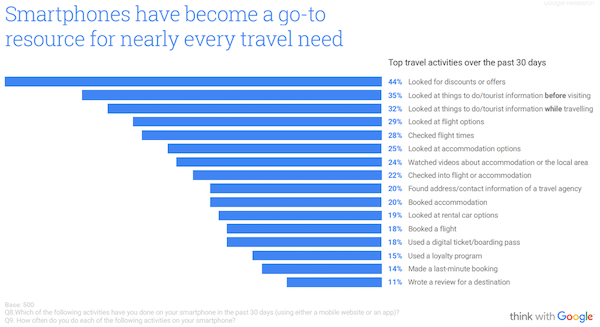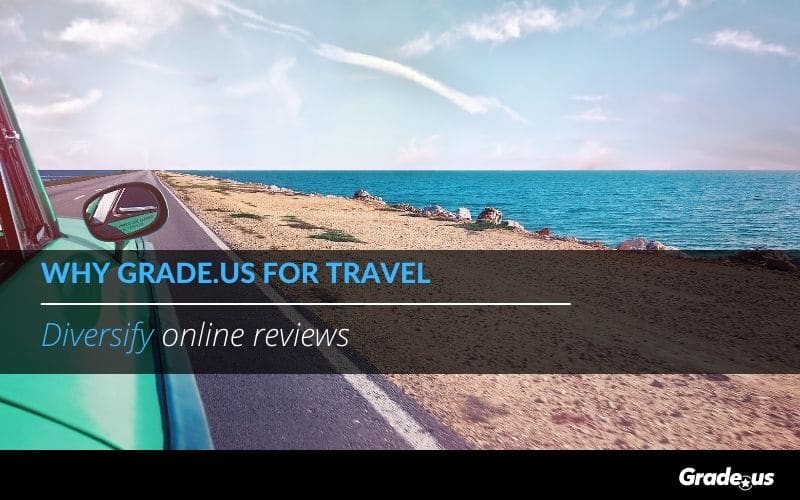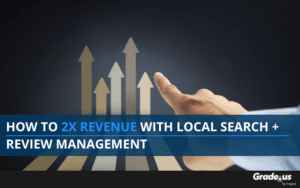TripAdvisor reaches 60 percent of all worldwide travelers purchasers
What about the other 40 percent?
Research shows that 74 percent of all travelers use TripAdvisor in some fashion to plan their trip. At first glance, this seems like a slam dunk. If you’re running a travel business, focus your attention on TripAdvisor.
Sounds like a good plan, right?
Why focusing on TripAdvisor (or a single site) is bad for business
This doesn’t sound right.
As of 2019, TripAdvisor has 795 million reviews; they receive 490 million unique visitors per month, and they have more than 8.4 million listings on their platform.
That sounds like a lot.
If we take a look at the review landscape, some interesting facts jump out at us.
1. Google has almost 60 percent of all reviews on planet Earth.
Google accounts for 57.5 percent of all reviews worldwide across all review platforms; Facebook accounts for 19 percent, TripAdvisor 8.4 percent, and Yelp with 6.6 percent. Other platforms account for a modest 8.6 percent.
The implications are obvious, right?
If you’re in the travel industry, TripAdvisor is an essential platform. The majority of customers, 53 percent, refuse to commit to booking until they read reviews. However, if you want consistent, long-term growth, you’re going to need strong review profiles on other platforms.
2. Google dominates maps and search.
Research from Think with Google shows 51 percent of smartphone owners use their devices for travel-related activities. Of those, 71 percent do so weekly.
Why is this important?
The vast majority of these activities begin with Google. These are common searches travelers use to plan their activities, but they’re also strong buying signals.

If you’re taking a vacation, there’s a good chance you’ll need to rent a car or book a hotel. Here’s the thing about these search activities.
- Each of these tasks leads prospective customers to online reviews
- The majority of these travel activities begin on Google
- These searches lead travelers to industry-specific hubs (e.g., Booking.com, Viator, Yelp, etc.)
Another key point is the fact that these travel platforms have a dedicated following. If you focus on TripAdvisor but exclude Google reviews, you’ll miss a significant amount of traffic.
3. Review diversity is the key to dominating search results
Research from Moz found businesses risk losing as many as:
- 21.9 percent of customers if you have just one negative review listed on page one of Google
- 44.1 percent of customers if you have two negative results
- 59.2 percent of customers with 3 negative results
- 69.9 percent of customers with 4 negative results
Here’s the good news.
A strong and diverse review portfolio achieves the opposite here. If you have several review profiles across key travel review sites (Google, TripAdvisor, Yelp, Booking, etc.), this translates to more visibility, traffic, and revenue.
How do I know?
Google tells us that they rank brands locally based on three factors:
- Relevance
- Distance
- Prominence
Here’s what they say about the third factor, prominence.
"Prominence is also based on information that Google has about a business, from across the web, like links, articles, and directories. Google review count and review score factor into local search ranking. More reviews and positive ratings can improve your business' local ranking. Your position in web results is also a factor, so search engine optimization (SEO) best practices apply."
They’re upfront about it.
The stronger your review portfolio, the better your local search rankings will be. This means your potential upside, financially speaking, is huge.
Related: How to Optimize your TripAdvisor profile to maximize the number of customers you attract.
The potential problems of relying on Travel profiles
Many business owners feel that a TripAdvisor profile is all they need. They can use their tools to grow their business. This is true, to a point.
There’s a sobering reality many haven’t acknowledged.
TripAdvisor is the travel behemoth, so I’m going to focus my attention there. For starters, TripAdvisor is focused primarily on its users. They charge brands a toll to get in front of their users but make no mistake, their loyalties are focused on users.
What does this mean for your business?
- TripAdvisor tools, while helpful, will be geared towards serving the users
- The TripAdvisor model for brands is pay-to-play. If you want more visibility, you’ll be expected to pay for it
- They’re far more likely to side with customers in a dispute
- TripAdvisor is unable to help you with your review portfolio across other sites
- They can only provide you with promotional tools to market reviews from their site (what about Google, Facebook, Yelp, Booking, and others?)
- Their platform is self-service; they take zero responsibility for any issues between you and the customer
- A few negative reviews can demolish your revenues and put you out of business
- If TripAdvisor is your meal ticket, any disruptions (e.g., downtime, updates, administrative issues) can be devastating for your business
Here’s the most alarming part about all of this. What I’ve shared can be applied to any travel platform or review site. The state of the industry is generally pro-customer.
What’s the solution, then?
The solution is balance; building a strong and balanced review portfolio across various review sites means you defang the potential problems that come with relying on one or two platforms exclusively.
- Sending out review requests and building your review portfolio organically means you’ll receive more attention via Google’s local pack, knowledge panels, maps, and rich snippets.
- You’ll see a consistent ranking lift as positive reviews improve your brand’s prominence
- A few negative reviews (even received consistently) won’t devastate your business financially if your business has strong aggregate reviews across multiple platforms
- A consistent review management plan means you’ll be able to consistently bury negative reviews that are malicious, fraudulent, or inappropriate
- A third-party review platform enables you to market and promote your review portfolio consistently across a variety of marketing channels — websites, social media, widgets, and more
- Your business will be able to weather any disruptions (e.g., downtime, updates, administrative issues) from any specific platform
- With the right tools, you’ll be able to spot trends that are platform-independent (e.g., Yelpers have different preferences and expectations vs. customers on TripAdvisor, customers in various locales have different needs or expectations) and respond to them appropriately
- As your aggregate reviews improve, your local rankings will follow. Once your rankings begin to grow, your ROI and aggregate reviews will continue to improve, creating a virtuous cycle
Here’s the issue.
If you’re running a small business, you may not have the time to keep up with multiple travel sites. If you’re handling things manually or via their tools, this could become a full-time job on its own!
Related: What parts of your TripAdvisor profile will have the most impact on your rankings and revenue? See for yourself!
How to manage multiple travel and review profiles
It’s easy if you have the right tools and team.
See what I did there?
It would be easy to find a random tool that has some or all of what you need. At some point, you’re going to need mission-critical help from real people. Here’s what you’ll need.
- Intelligent and automatic review requests: TripAdvisor encourages businesses to request customer reviews; Yelp says this is a violation of their terms of service. You’ll need a third-party tool like Grade.us that understands the weird quirks of each platform and automates the process for you with prewritten follow-up messages delivered via text, email, or snail mail.
- Review sorting functionality allows you to tag and search through reviews to identify important details or trends you can use later on.
- Consistent review monitoring, whether they’re first or third-party reviews. You’ll want a solution that automatically pulls in reviews from your profiles, allows you to add reviews manually or add reviews in bulk.
- Automated review marketing allows you to schedule selected reviews or intelligently choose which reviews to share or stream to your website, social media, or widgets based on pre-determined criteria.
- Detailed analytics that provides you with hard data on the travel sites that perform best. You should have full access to data like rating distribution (i.e., positive to negative ratios), review trends, sentiment analysis, campaign performance, clickthroughs, and positive reviews. Your tool should allow you to schedule, automate, and white label reports (franchises, multi-location, etc.).
- Account management options to define user access and reporting. You should have the opportunity to receive performance data for each of your sub-accounts.
- Rock-solid support provides you with the customer service, product, and integration support you need if you run into any of the issues I’ve covered above.
So, where would you find a solution that meets these criteria?
*cough*
Shameless plug, Grade.us meets all of the criteria I’ve listed above. 😉 It comes with a free 14-day trial, no credit card required. We want to earn your trust, so we’re eager to have you take our platform for a test drive.
There are other options.
Third-party platforms like GatherUp, Review Trackers are options you can test as well. So what’s the big takeaway here? It’s absolutely essential that you focus on multiple travel and review sites to maximize the benefits you receive.
Focusing on TripAdvisor is bad for business
As we’ve seen, 60 percent of all worldwide travelers rely on TripAdvisor; 74 percent of all travelers use TripAdvisor to plan their trip. A majority of these customers, 53 percent, refuse to commit until they’ve seen reviews.
A single site isn’t enough for your business.
Google, Facebook, and Yelp account for 83 percent of all reviews worldwide across all review platforms; TripAdvisor has just 8.4 percent. If you want to build a strong review portfolio that drives traffic, increases revenue, and boosts returns, you need to focus on multiple sites.
A third-party tool like Grade.us is a must.
It’s an absolute win for your business; with the right tools in place, you’ll have everything you need to boost prominence, visibility, and traffic via your reviews, no specialization required.
Try it free: Turbocharge your Google, Facebook, Yelp, and TripAdvisor profile with Grade.us; our tools make review management easy and automatic. Try it free for 14 days; no credit card required.










